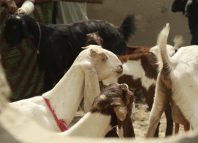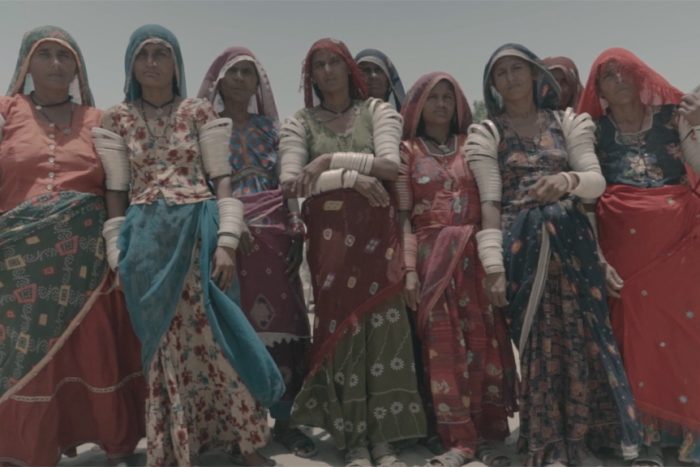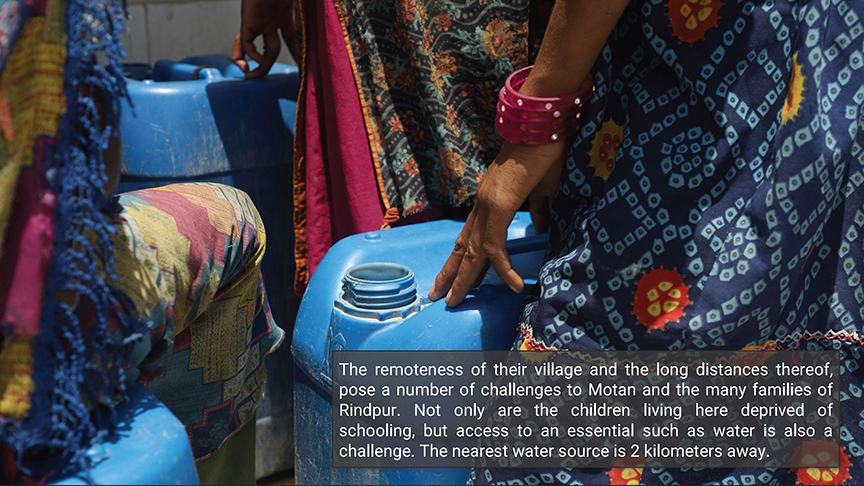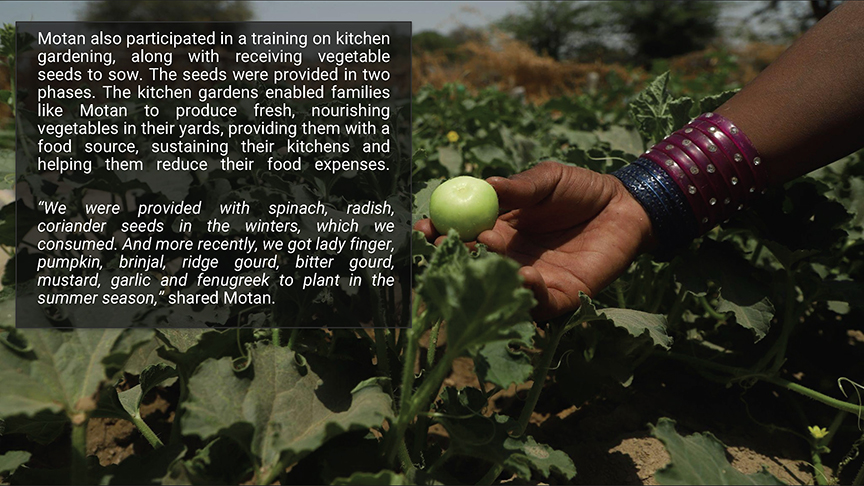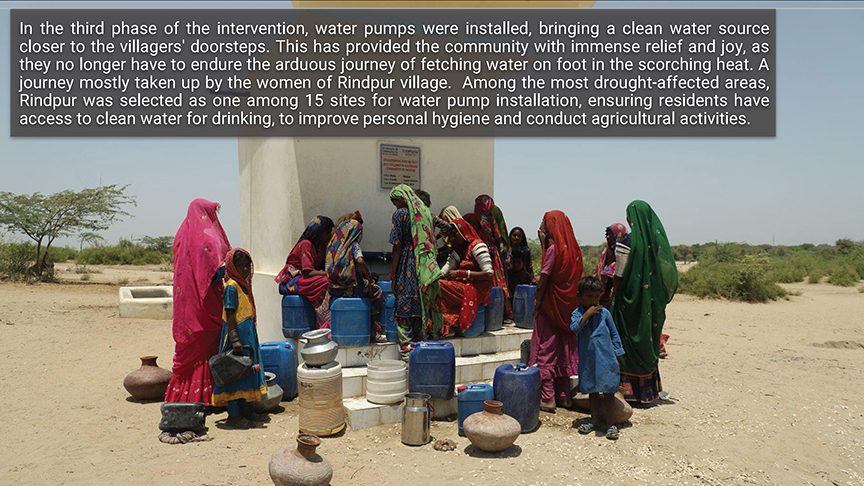Last year, we traveled to the Thar region of Umerkot to document the transformative impact of the Humanitarian Assistance, Early Recovery, and Development (HERD) Project, supported by Canadian Foodgrain Bank (CFGB) and Presbytarian World Service and Development. (PWS&D). Through our lens, we captured stories of resilience, hope, and progress. Six months later, we returned to the village to share the documentary with the very people whose lives it portrayed. The entire community came together to witness their own stories unfold on screen—a moment of reflection, empowerment, and collective strength.
Archives
Weathering the Storm: A Family’s Quest for Stability in Umerkot
Latifan, a 20-year-old woman from Ramo Vehro, UC Faqeer Abdullah in Umerkot, lives with her husband, Yaseen Muhammad, and their three-year-old son, Umer. The household also includes her brother-in-law, his wife, and their three children, making it a family of eight living under one roof. Yaseen works as a daily wage labourer, earning PKR 500 (approximately USD 1.8) per day, though there are occasional opportunities where he earns up to PKR 1000 (approximately USD 7.2) for a day’s work. The family’s monthly expenses amount to around PKR 8,000 (approximately USD 28.7), covering essential grocery items such as wheat, sugar, tea leaves, and rice.
In 2021, a severe drought devastated Latifan’s village, destroying agricultural lands and decimating livestock. The family farmed on four acres of shared land, cultivating cluster beans and millet. However, the drought rendered their crops useless, leaving them in a dire economic state. The family faced a very challenging time but they have persevered and remained resilient.
Community World Service Asia (CWSA), with support from Diakonie Katastrophenhilfe (DKH), initiated a Multi-Purpose Cash Assistance programme in the drought-affected regions of Umerkot. The initiative provided PKR 17,000 ( (approximately USD 61) per household every month for three months—September, October, and November—benefitting 460 households, including Latifan’s family. Their inclusion in the programme was due to their large household size, low income, and farming background. Upon receiving the first tranche of PKR 17,000, Latifan prioritised purchasing wheat for PKR 10,000 (approximately USD 36), with PKR 1,000 (approximately USD 3.6) allocated to land preparation expenses. The remaining PKR 6,000 (approximately USD 22) was spent on groceries such as lentils, rice, and tea leaves, leaving her with PKR 1,000 (approximately USD 3.6) in savings.
Latifan’s aspirations for the remaining instalments include repairing their home and purchasing a mobile phone to facilitate better communication. Her leadership skills are evident through her active participation in the community as a member of the Village Management Committee led by CWSA. As deputy president, she not only takes training sessions from CWSA’s women mobilisers but also shares her knowledge on cultivation and harvesting techniques with other women farmers in the community. Her confidence and proactive nature have made her a key contact for NGOs organising community visits.

The cash assistance programme has significantly improved the family’s living conditions, enabling them to afford three meals a day. Previously, they managed only one or two meals daily. The family’s meals now consist of a good breakfast, potato curry for lunch, and chapati (flatbread) with curry for dinner. They live in a modest two-room house shared between Latifan’s family and her brother-in-law’s household. Their combined livestock of seven goats—four belonging to the brother-in-law and three to Latifan—provides milk for household consumption, with additional milk sold by her brother-in-law, who earns PKR 200 to 300 (approximately USD 1) as a shepherd.
Despite these improvements, Latifan’s family continues to face hardships. The lingering threat of drought hampers agricultural recovery, and Yaseen’s fluctuating income barely meets their needs. A mounting debt of PKR 200,000 (approximately USD 720) weighs heavily on the family, accrued primarily from food purchases and medical expenses, including PKR 40,000 (approximately USD 144) for Latifan’s cesarean operation when her son was born. Health remains a top concern, particularly with her son being susceptible to common childhood illnesses like flu, fever, and cough, which could hinder his healthy growth. Additionally, her nephew’s sleep disturbances pose a further health worry. However, through hard work and payments made to the landlord, they have managed to repay PKR 100,000 (approximately USD 360) of the debt.
Latifan’s determination remains unwavering. Her family plans to use the forthcoming assistance to improve their land conditions, resume crop cultivation, and allocate PKR 10,000 (approximately USD 36) towards further debt repayment. With a vision for a more stable future, Latifan continues to lead her household and community with resilience, striving for financial independence and a sustainable livelihood amidst ongoing challenges.
Seeds of Resilience
Pakistan—the fifth most populated country in the world—is extremely vulnerable to climate change and food insecurity. The Global Climate Risk Index ranks Pakistan as one of the most climate-affected countries in the world. With an economy heavily reliant on agriculture (almost 20% of GDP), even minor climactic incidences can have dramatic effects on food security.
To help build seeds of resilience in marginalised communities, CWSA implemented a humanitarian assistance, early recovery, and development (HERD) project, with the support of PWS&D, in highly food-insecure Sindh province.
The project, which supported 23,319 people, provided emergency food assistance during the first stage of intervention. Further stages provided families with seeds and training on climate-smart agriculture. Additionally, 300 women artisans received training to expand their livelihood opportunities.
Watch the Seeds of Resilience video, which documents the changes in the community, and then engage in discussion and dialogue using the provided discussion questions.
**This project received financial support from the Government of Canada through the Canadian Foodgrains Bank.
Sustainability & Hope: Khadeeja Khatoon’s Optimistic Approach for a Better Life






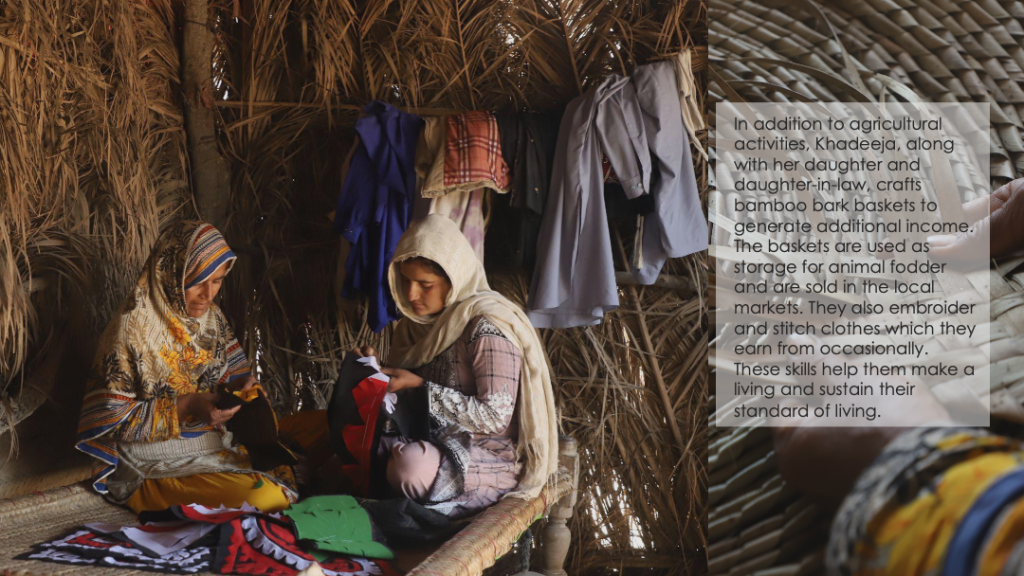

Bringing Hope and Health Back to Flood-Affected Khairpur
Sawal and her husband Sikandar Ali, a driver, faced immense hardship when they lost their livestock and home during the torrential rains. For almost two months, the couple and their five-year-old daughter were forced to live in makeshift tents on higher grounds, on a sharing basis with other villagers. In June 2022, the rural areas of Sindh were severely impacted by heavy rains, devastating villages and leaving the residents in dire conditions. Subhan Panhyar village, located in Khairpur District, was among the hardest hit, with nearly everyone left without land and food.

The villagers had to ration food items among themselves for months, often finding it insufficient. There were days when the village elders went without food to ensure the younger children could eat. Sawal and her family endured this struggle for two months, compromising on food, shelter, and land. The rains took everyone’s possessions and destroyed the lands that provided a means of livelihood. In the villages of Khairpur, nearly every family worked in the fields and depended on agriculture, but the floods struck just as the land was ready for harvest. The rains ruined everything, leaving the villagers without crops to sell or consume, which severely worsened their situation.
Sawal, after having her daughter, tried to conceive another child many times, but nothing seemed to work. The long gap between having children was distressing for her family, who desperately desired a new family member. Sawal and Sikandar traveled from their small village to Ranipur in search of better clinics but their efforts were unsuccessful. Sikandar also took Sawal to a government hospital in Karachi, but they returned empty-handed.
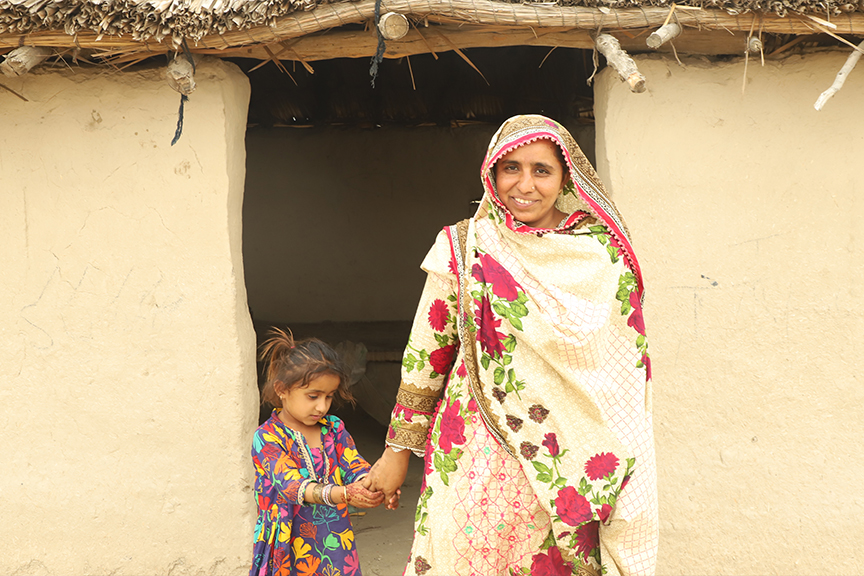
“It used to cost us a lot,” Sawal said, “A trip to Sukkur would mean spending PKR 2000 (approx 7.2 USD) on commuting and another 1500 PKR (approx 5.4 USD) on prescribed medicines. When we went to Karachi, we ended up in extreme debt. I took a loan of PKR 20,000 (approx 72 USD) from my boss, where I work as a driver, but we had to return because we couldn’t afford the living expenses in a city like Karachi.” Despite their efforts and expenses, Sawal was still unable to conceive, leaving her devastated.
Community World Service Asia (CWSA) has been implementing flood response projects in flood affected districts of Sindh, including Khairpur. With the support of Disaster Emergency Committee (DEC) and CAFOD, CWSA launched a Flood Recovery Response that included the establishment of two Rural Health Clinics (RHC), the provision of two Mobile Health Units (MHU), and free medicines, awareness through medical camps and health sessions.
When a community mobiliser of CWSA held a health session in Subhan Panhyar, the villagers were informed about the visiting hours, location, and health facilities of the nearby Mobile Health Unit. Upon hearing this, Sawal wasted no time and decided to visit the clinic.
In January 2024, when Sawal visited the clinic for the first time, she was prescribed medications to improve her health, including calcium and vitamins. After just one month of consistent treatment, Sawal was able to conceive. “I could not believe it when the doctors gave me a strip test, and it came back positive,” Sawal said. “We had been trying for months with no success. It was the lady health workers and the medications from the health unit that made the difference. Previously, doctors had given me medications without explaining the problem. At the clinic, they told me my body was too weak to bear a child. Once my health improved, I conceived quickly.”

The medical staff guided her to maintain a healthy diet and lifestyle, ensuring both she and her baby received the necessary nutrients for a healthy pregnancy. Sawal is now three months pregnant. She has visited the clinic twice—once when she was upset about not being able to conceive, and the second time to inform the Lady Health Worker (LHW) and Lady Health Visitor (LHV) of her pregnancy. She continues to visit the clinic as needed, receiving medicines for her unborn child, herself, and occasionally for her daughter if she is unwell.
“We wasted so much money on city doctors and medicines. If only I had known earlier about this health clinic, we wouldn’t be in debt,” Sawal reflected. Currently, Sikandar owes his boss PKR 20,000, but Sawal is hopeful that they will repay it. With their desire for a new baby almost fulfilled, Sikandar is now free of stress and works day and night to earn more as their family will soon be expanding.
Since the project’s implementation in March 2023, a total of 40,556 patients have visited the Rural Health Clinics (RHCs) for the first time, and 48,945 patients have visited the MHUs for general OPD. At the RHCs in Nara Gate and Choondko, primary health care services are provided, including General OPD, Antenatal Care (ANC), Prenatal Care (PNC), and normal baby deliveries. Each day, the dedicated CWSA staff at these RHCs and Mobile Health Units (MHUs) accommodate up to 120 patients at each location, ensuring that vital healthcare services reach those in need.
Relentless Downpours Disrupt Life in Pakistan Yet Again
The 2024 monsoon season has wreaked havoc across Pakistan, especially in Balochistan, Punjab, and Sindh. Heavy rains have led to widespread flooding, landslides, and significant infrastructure damage. Unusually high temperatures have exacerbated the situation, accelerating snowmelt in regions like upper KP, Azad Jammu and Kashmir, and Gilgit-Baltistan. According to the National Disaster Management Authority (NDMA), as of September 1, the country has experienced above-average rainfall and a total of 306 people have lost their lives, including 155 children. Additionally, 584 people have been injured, with 212 of them being children.

Moreover, the Pakistan Meteorological Department has announced today that a moist current from the Bay of Bengal is expected to move into the upper parts of the country from September 2. Rain, wind, and more thundershowers are predicted for Sukkur, Larkana, Khairpur, Dadu, Jacobabad, Karachi, Hyderabad, Thatta, Badin, Tando Allahyar, Tando Muhammad Khan, Tharparkar, Mithi, Mirpur Khas, Umerkot, and Sanghar on September 3 and 4. Farmers are advised to manage their activities according to the weather forecast.
A strong spell of monsoon rain is anticipated in the tribal areas of Dera Ghazi Khan from September 2 – 7, which may result in severe flash floods in Rajanpur and DG Khan. PDMA Balochistan has declared 12 districts as calamity-hit.
Extreme Weather Causes Chaos in Sindh
Pakistan’s Indus River experienced a significant surge in water levels from upstream, resulting in severe flooding in the kacha areas (riverine regions) in Sindh. In Khairpur district alone, 33,178 people were affected including 11,060 men, 13,700 women, and 4,209 children. Union Councils (UCs) Ripri of Taluka Gambat, Sadar Ji Bhatyoon, Hadal Shah, and Rahoja/Mohal in Taluka Kingri are significantly affected by subsequent flooding.
In Mirpur Khas, heavy rains began on August 26, submerging UC Roshan Abad and UC Khuda Bux in Taluka Jhuddo. On August 28, 131 mm of rain was recorded in Mirpur Khas resulting in a total of 1,477 houses left partially or completely damaged.
In Umerkot, 149 mm of rain was recorded this past week, leaving UC Kundri and Samero underwater. This forced residents to migrate and caused massive damage to their homes.
In Mirpur Khas, almost all onion, cotton, and fruit crops are submerged, with only sugarcane unaffected. This has worsened the situation for the affected population, who rely heavily on agriculture for their livelihoods. In Khairpur, 80% of the ready crops are damaged.
Flood affected communities are suffering from water borne and climate induced diseases, such as malaria, diarrhea, scabies and gastroenteritis, while pregnant women and newborn babies are experiencing malnutrition due to limited food supply, low resources and lack of health facilities. With roads and communication channels temporarily lost, pregnant women have no access to quality delivery services leading to delayed, unhygienic and problematic labour cases. The animals in the communities are also suffering from waterborne diseases, with an acute shortage of fodder.
Many families, along with their remaining livestock, have sought refuge on protected bunds as most villages in flood-hit districts are left submerged. Despite some water discharge, the water level has continued to rise, creating an alarming situation, especially if further rainfall occurs or upstream flooding happens.
Flood affected communities in Sindh are in urgent need of humanitarian assistance including:
- Food: Immediate provision of food supplies to ensure affected individuals have access to nutritious meals.
- Multi-Purpose Cash Assistance: Financial support to affected families to enable them to purchase essential items and meet their immediate needs according to their priorities
- Emergency Shelter and Non-Food Items (ESNFI): Distribution of essential items like tarpaulin tents, household items, and sleeping mats to provide shelter and comfort to those displaced by the flooding.
- WASH (Water, Sanitation, and Hygiene) and dignity kits: Provision of clean water, sanitation facilities, and hygiene kits to prevent the spread of diseases and maintain personal hygiene, preserving the dignity of affected individuals.
The Deputy Commissioner, Khairpur has appealed to the aid community to extend their support to katch and low-lying areas of District Khairpur, that have been declared calamity hit. Local and provincial authorities and the humanitarian community are closely coordinating to plan and respond in an efficient and effective way. A joint assessment led by international humanitarian organisations has also been completed for Khairpur and Sukkur divisions in late August which has verified and reinforced the need for the assistance mentioned above.
The Provincial Disaster Management Authority (PDMA) of affected provinces are managing the response. The District Disaster Management Authority (DDMA) recently issued a call for a localized response, urging humanitarian partners to assist the affected people.







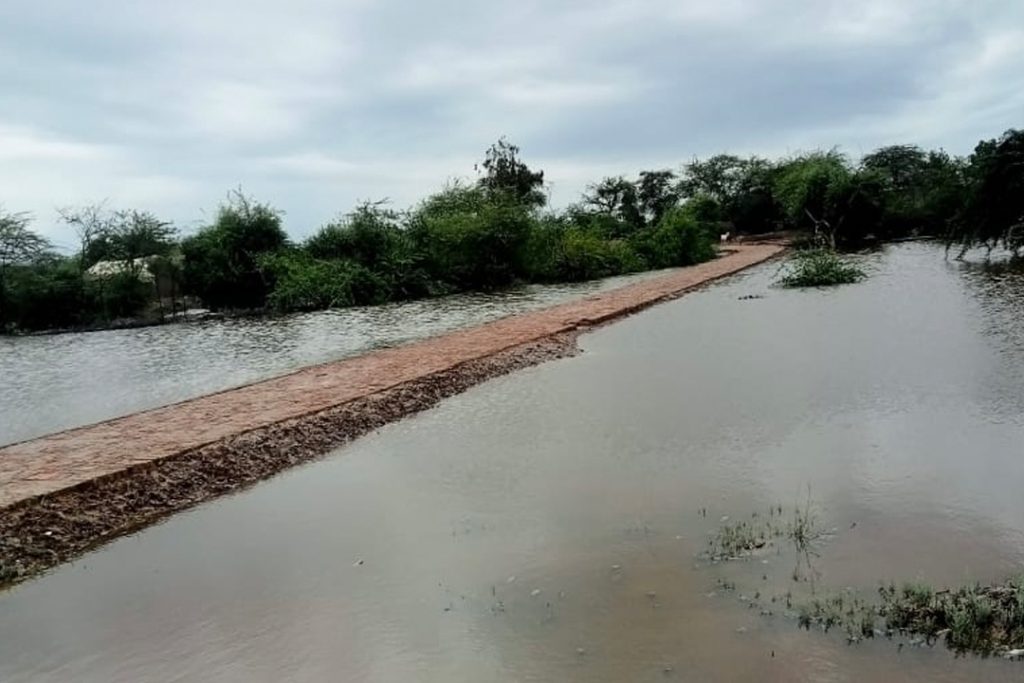
Community World Service Asia’s Response
Community World Service Asia (CWSA) is in close coordination with the local government, affected communities and other stakeholders active in the region. To address the urgent health needs of the affected population, our health teams are on the ground, delivering essential primary healthcare services through our Mobile Health Units and Free Medical Camps. Our mobile units are equipped to reach remote and severely impacted areas, providing critical medical care, disease prevention awareness and medicines, and health education to those who have been displaced or are otherwise unable to access traditional healthcare facilities.
We have been providing medical assistance and conducting health education sessions in nearly all the rain-affected areas of Mirpur Khas and Khairpur. On Friday, August 30, in Mirpurkhas’s Benazir Colony village, where over 150 homes remain submerged, CWSA’s team held a free medical camp, serving 162 patients and distributing essential medicines and hygiene materials. A one-day free medical camp in village Tapa Doulatpur of the same district was also set up, conducting 142 OPD sessions, along with health and hygiene awareness sessions for men, women and children. The most highly reported medical cases included fever, skin infections, diarrhea, ENT issues, eye infections, and UTIs.
In addition to the ongoing response, CWSA proposes the following humanitarian actions based on the current needs:
- Multipurpose Cash Assistance (MPCA)
- Emergency Healthcare
- Dignity & Hygiene Kits
- Temporary Shelter Kits
- Promoting Quality & Accountability in Humanitarian Action
Community World Service Asia’s team is coordinating with the District Government and the District Health Officer (DHO) who have requested for additional medical camps in Mirpur Khas to assist affected communities. We are also in close coordination with other humanitarian actors and disaster management authorities and participated in a cross-sectoral meeting to assess the on-going situation and plan a coordinated response in the Sukkur & Khairpur Division. This meeting was led by UNOCHA and IOM and was attended by 28 INGOs/NGOs.
As the crisis unfolds, our efforts will focus on mitigating the ongoing challenges faced by affected communities, ensuring they receive the necessary support to rebuild their lives and recover from yet again another climate disaster.
Contacts:
Shama Mall
Deputy Regional Director
Programs & Organisational Development
Email: shama.mall@communityworldservice.asia
Tele: 92-21-34390541-4
Palwashay Arbab
Head of Communication
Email: palwashay.arbab@communityworldservice.asia
Tele: 92-21-34390541-4
Sources:
Relief Web
PDMA, Sindh
NDMA
Pakistan Metrological department
Office of the Deputy Commissioner, Khairpur
Joint Fact-Finding Mission Report, Khairpur & Sukkur Division.
Pakistan Flood Crisis: Monsoon Floods Leave Thousands in Need of Help in Khairpur

Pakistan’s Indus River experienced a significant surge in water levels from upstream, resulting in severe riverine flooding in the kacha areas (riverine areas) as monsoon rains hit several provinces in full force this week. These riverines and flash floods have both caused wide spread damages in different areas of Pakistan. In Sindh province, district Khairpur is among the most severely hit, with one person reported dead, two seriously injured, and thousands affected, requiring urgent humanitarian assistance and rehabilitation efforts.
A total of 3700 hundred families in Khairpur alone have been affected by the torrential rains and subsequent floods, with 270 families (along with their livestock, for most families a sole livelihood source) left displaced, and temporarily relocated along the protective bands or with relatives. Local authorities and field teams report 28,969 people affected (11,060 men, 13,700 women, and 4,209 children) in 36 villages in the district.
Flood affected communities are suffering from water borne and climate induced diseases, such as malaria, diarrhea, scabies and gastroenteritis, while pregnant women and newborn babies are experiencing malnutrition due to limited food supply, low resources and lack of health facilities. With roads and communication channels temporarily lost, pregnant women have no access to quality delivery services leading to delayed, unhygienic and problematic labour cases. The animals in the communities are also suffering from waterborne diseases, with an acute shortage of fodder.
Extensive damage to local infrastructure and agricultural lands due to the floods have also been reported. Thousands of hectares of standing and prepared crops, including cotton, dates, bananas, jowar (Sorghum), and vegetables, have been destroyed. More than 25 primary, elementary, and high schools have also been partially damaged, ruining the educational infrastructure, furniture, and fixtures, and disrupting academic activities just when the schools had reopened for new term.
An emergency needs assessment has identified the following needs:
- Evacuation, rescue, relief, and rehabilitation efforts
- Food Support
- Non Food Items (NFI)
- Shelter Kits
- Medical camps with medicines and ambulance services
- Nutritional support for children
- Tent-schools and child-friendly spaces
- WASH support, including Hygiene kits, Dignity Kits and Pit toilets
- Hand pumps and drinking water
- Animal fodder, treatment, and vaccination
Homes have been destroyed, families displaced, and essential resources are scarce. Immediate support and action are urgently needed to provide relief and rebuild lives.
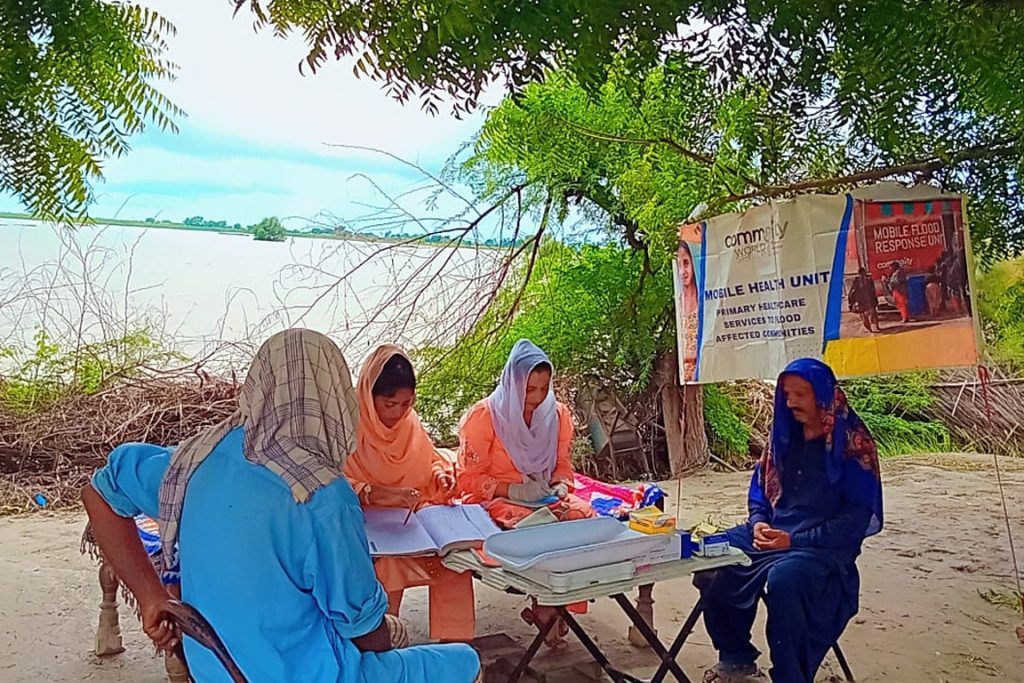





Community World Service Asia’s Response: Community World Service Asia (CWSA) is in close coordination with the local government, affected communities and other stakeholders active in the region. To address the urgent health needs of the affected population, our health teams are on the ground, delivering essential primary healthcare services through our Mobile Health Units. These mobile units are equipped to reach remote and severely impacted areas, providing critical medical care, disease prevention awareness and medicines, and health education to those who have been displaced or are otherwise unable to access traditional healthcare facilities.
Contacts:
Shama Mall
Deputy Regional Director
Programs & Organisational Development
Email: shama.mall@communityworldservice.asia
Tele: 92-21-34390541-4
Palwashay Arbab
Head of Communication
Email: palwashay.arbab@communityworldservice.asia
Tele: 92-21-34390541-4
Sources:
Relief Web
NDMA
Pakistan Metrological department
Dawn
Contingency Plan for Pakistan – 2024
As we approach the monsoon season, we are reminded of the devastating impact that floods and extreme climate change have had on Pakistan in recent years. In light of this, Community World Service Asia (CWSA) is committed to ensuring a swift and effective response to the anticipated floods in 2024. The National Emergency Operation Centre of NDMA (Pakistan) warned last Tuesday of strong monsoon currents likely to penetrate from the Arabian Sea and Bay of Bengal in upper regions of Pakistan, resulting in a series of rains across various parts of the country in the coming days and weeks. Read the latest Pakistan Meteorological Department (PMD) report here.
The contingency plan attached is an overview of CWSA’s approach and capacity to respond to the forecasted floods in Pakistan. It highlights the response capacity, available resources, vulnerable geographical areas and available opportunities that can be immediately deputed/utilised to kick off the emergency response.
CWSA’s History and Presence in Pakistan
Community World Service Asia has a long-standing history of over 50 years in Pakistan, working closely with local communities, government agencies, and international partners. Our deep-rooted relationships and extensive presence across the country have enabled us to respond effectively to various emergencies and development challenges. With six operational offices spread across the country, our capacity to operate in all provinces of Pakistan ensures that we can reach the most vulnerable populations swiftly and efficiently.
Preparedness and Response Capacity
In preparation for the anticipated floods, we have mobilised our resources and are ready to deploy six fully functional Mobile Health Units (MHUs). These units are equipped to provide essential medical services, including primary healthcare, maternal and child health, and emergency medical care. Additionally, we have prepositioned a substantial stock of medicines and medical supplies to address immediate health needs.
We have also established Memorandums of Understanding (MOUs) with Mobile Cash Transfer Service providers to facilitate rapid and secure cash assistance to affected families. Our technical and sectoral expertise spans across various domains, including:
- Quality & Accountability: Ensuring that our interventions promote accountability to affected people and meet the highest standards of quality humanitarian assistance outlined by global standards and practices.
- Health: Providing emergency healthcare services to affected communities.
- Psychosocial Support: Addressing the mental health and psychosocial needs of flood-affected individuals.
- Cash Voucher Assistance: Delivering timely financial support to help families meet their urgent needs in a dignified manner.
- Water, Sanitation, and Hygiene (WASH): Ensuring access to clean water, sanitation facilities, and hygiene promotion.
- Monitoring & Evaluation (M&E): Continuously assessing the impact and effectiveness of our interventions.
Human Resources and Coordination
Our HR scale-up roster is in place, allowing us to rapidly deploy experienced staff to the affected areas. We have also established a robust coordination mechanism with local level line departments, PDMA/NDMA, international non-governmental organisations (INGOs), and local NGOs to ensure a harmonised and efficient response.
Through our comprehensive contingency plan, combined with our experience and resources, we aim to support flood affected communities immediately and effectively. To achieve this, we are establishing a Rapid Response Fund (RRF), enabling us to mobilise resources and respond within 24 hours of the occurrence of the flood. Your contribution will ensure that essential supplies such as food, clean water, medical aid, and cash will reach flood survivors without delay.
Water, Food & Growth: Sustainable Interventions for Climate Affected Umerkot
Scorching Surge: Sindh and Punjab on High Alert as Heatwave Temperatures Soar
The National Disaster Management Authority (NDMA) on Thursday warned that extreme heatwave conditions would persist across parts of Sindh and Punjab in June, with temperatures likely to remain above 48 degrees Celsius.
The authority’s National Emergency Operations Centre said that Umerkot, Tharparkar, Tando Ala Yar, Matiari and Sanghar districts in Sindh are expected to be affected, while in Punjab, Rahim Yar Khan and Bahawalpur are most likely to experience heatwave conditions.
In its advisory, NDMA also said that from May 31 to June 5, dust storms, gusty winds and light rain are also likely to occur in the upper regions of the country.
Extreme Weather Conditions
On Thursday, harsh weather conditions persisted across the Sindh province, even though temperatures dropped in most cities.
The Met Office recorded the maximum temperature in Jacobabad at 50.5°C, followed by Dadu at 49°C . Except for Karachi, which barely missed the mark with a high of 39.5°C and 63 per cent humidity, all other cities in the province registered temperatures above the 40 degree-mark.
Severe heatwave conditions persist across most parts of the province with daytime maximum temperature being 6-8 degrees above normal in Dadu, Kambar Shahdadkot, Larkana, Jacobabad, Shikarpur, Kashmore, Ghotki, Sukkur, Khairpur, Naushahro Feroze, Shaheed Benazirabad districts and 5-7 degrees above normal in Sanghar, Hyderabad, Mitiari, Tando Allah Yar, Tando Mohammad Khan, Mirpur Khas, Umerkot, Tharparkar and Badin districts.
The heatwave conditions are likely to persist till June 1st.
Warning the authorities to remain alert and take necessary measures, the NDMA advisory urged citizens to stay hydrated, avoid outdoor activities between 11am and 3pm.
Many labourers from remote areas travel daily to cities for work, but the current heatwave has severely disrupted their livelihoods pattern and led to worsening health conditions. The extreme heat makes commuting difficult.
The heatwave has also impacted people staying at home, as inconsistent electricity and lack of cooling options limit their ability to cope with prolonged heat stress. The ongoing hot and dry weather is stressing water reservoirs, crops, vegetables, and orchards, while also increasing energy and water demand, which is difficult to manage during the current crisis.
Community World Service Asia’s Response:
Community World Service Asia (CWSA), in collaboration with district authorities, has established a heatstroke centre/camp at the District Headquarters (DHQ) Hospital in Umerkot. The CWSA team initially launched their services by providing cold drinking water, conducting awareness sessions, and referring heatstroke patients to the DHQ. These awareness sessions are delivered directly to pedestrians, patients, and their attendants, messages to prevent heat strokes and raise awareness on precautionary measures are also broadcasted over speakers for public awareness. Every day, more than 1,000 people visit the centre to quench their thirst, as there is no fresh water facility available nearby to them. People not only come to drink water but also carry some back for family members or relatives who are hospitalised at the DHQ. So far, 20 critical patients have been referred to the emergency department after receiving initial treatment.
The CWSA health team has set up heatstroke corners at each public dispensary operated by CWSA to manage emergency cases and serve patients visiting from nearby villages seeking urgent medical services in the extreme heat. The team provides cold drinking water, first aid, ORS, and glucose sachets to visitors seeking medical care.
With additional support, CWSA also plans to establish three heatwave facilitation centres for three months in Umerkot district which will offer clean, cold drinking water, juice and shaded rest areas. Each centre will have generators, pedestal fans, stretchers, necessary furniture, basic medical equipment, and medicines. Two Lady Health Visitors (LHVs) and two medical technicians will rotate among the centres. The paramedic staff will perform emergency procedures such as checking blood pressure, administering medications, clearing airways, and initiating IVs if necessary. They will also apply cold bandages or towels to reduce body temperature. Critical patients will be referred to the nearest healthcare facility, with transportation provided.
These centres will also distribute informational, educational, and communication (IEC) materials to raise awareness about heat-related illnesses. The centres will operate throughout the peak summer months until the end of August.


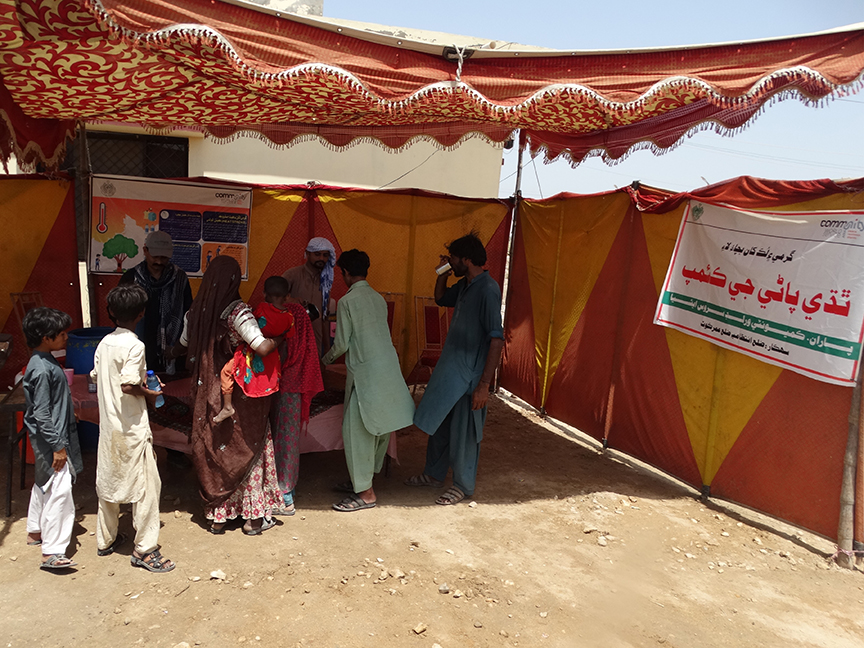




Contacts:
Shama Mall
Deputy Regional Director
Programs & Organisational Development
Email: shama.mall@communityworldservice.asia
Tele: 92-21-34390541-4
Palwashay Arbab
Head of Communication
Email: palwashay.arbab@communityworldservice.asia
Tele: 92-21-34390541-4
Sources:
Relief Web
NDMA
Pakistan Metrological department
Dawn


